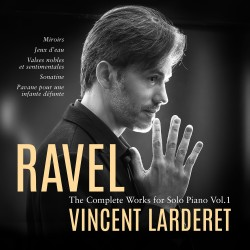Gapplegate Classical-Modern Music Review
Modern classical and avant garde concert music of the 20th and 21st centuries forms the primary focus of this blog. It is hoped that through the discussions a picture will emerge of modern music, its heritage, and what it means for us.
Search This Blog
Thursday, July 25, 2024
Charles Ives, Sonata No. 2, "Concord Mass, 1840-1860," Donald Berman
Friday, June 21, 2024
Lewis Gill, Parochial Chamber Works, Music Inspired by Warrington, Volume One
Monday, June 10, 2024
Nova Pon, Symphonies of Mother and Child, Turning Point Ensemble
That might be said enthusiastically for Canadian composer Nova Pon and her Symphonies of Mother and Child (Red Shift TK546). It puts together nicely an opening ten minute "World Within" with the five movements of the title work.
The chamber orchestra Turning Point Ensemble under conductor Owen Underhill transports us to a finely lyrical state of mind, redolent of some of the lyrical sides of Early Modernists such as Stravinsky, Milhaud, Ravel and such. As you listen however that similarity of expression morphs towards a music of a singular personality. And the music in time stands out as exceptionally memorable, at least to me.
"World Within"starts things off dramatically with a kind of endless modulation sequence between instruments with especially the trombone and trumpet heading a series of musical tag relay teams that articulate Neo-Classical roots and a very satisfying interplay, all with a processual development that thickens and increases complexities in the textural mapping of the score.
The four movement sequence comprising Symphonies of Mother and Child follows with a mysterious opening and a good deal of brilliant interplay. There are moments of movingly cyclical Minimal motifs yet they do not dominate as much as provide a kind of launching vehicle for tone-color variations that break free of the circular turnstyles typical of classic Minimal fare. As the music unfolds, we hear the major mode tonality emerging more and more with a kind of modal folksiness that gives it all a more contemporary feel--and it works very well as you follow the development throughout.
This is very intelligently wrought music by a true illuminati of total modernism. Bravo.
Highly recommended. A kind of milestone.
To hear a complete stream and find out how to order go to https://redshiftmusicsociety.bandcamp.com/album/symphonies-of-mother-and-child
Thursday, May 23, 2024
Johan Helmich Roman, Assaggi per Violino Solo, Fabio Bondi
Thursday, May 9, 2024
Denman Maroney Quintet, The Air Conditioned Nightmare
When Minimalist hypnotic circularity meets Free Jazz oriented geometric Pointillism we have something that makes sense and indeed when in the right hands such as here we have some sensational music. Pianist Denman Maroney has for some time been a thoughtful Free Jazz pianist. See my review of some of his Free Jazz music from my Gapplegate Music Review article of August 21, 2017 https://gapplegatemusicreview.blogspot.com/search?q=denman+maroney.
Monday, April 15, 2024
Rodney Sharman, Rachel Kiyo Iwaasa, Known and Unknown, New Music for Solo Piano
For me this one was a natural, the combination of vivid sound color, a modern yet a distinct melodic-harmonic foundation, ambient brilliance and a sort of eloquent expressionist pianism, a kind of moody, haunting thoughtfulness and a refreshing bit of text narrative and singing by the pianist in her enchanting performative role.
The eighteen short and longer works each hold their own in ultra-musical and inventive ways. That there is a Non-binary element in the thematics is the case thought for me it all works together as a poetic, lyrical whole so that I embrace it all as ART, which for me is what especially matters in the end.
Though the transcriptions are based on well known operas the end product stands out again as more in its finality of brilliance than as source inspiration.
This is piano music that thrives in its wonderful pianism, both in composition and performance. It stands out is a high point of the music I have heard thus far in the current year! Do not miss it.
Listen to a full stream on Bandcamp: https://redshiftmusicsociety.bandcamp.com/album/known-and-unknown-solo-piano-works-by-rodney-sharman
Wednesday, March 20, 2024
Vincent Larderet, Ravel, The Complete Works for Solo Piano, Vol. One
In this inaugural volume Larderet tackles five remarkably articulate and brilliant compositional sets, allowing the pianist to hold forth with novel and appealing interpretations that give us pause and move us along into Ravel's special aural world.
The set opens with Ravel's five movement Miroirs (1904-05) a breakthrough world of great sound color impressions and clangorous tonal brilliance. Larderet brings his own personally inventive aesthetics to each movement.
The 1903-05 Sonatine forms another high water mark of pianistic dazzle with effective stretching of rubato singularity that stands out among classic renditions since the advent of the LP Ravel's ravishing Pavane pour une infante defunte (1899) chimes in as another outstanding reading, a hovering liquidity of great beauty one should not miss in this reading. The Jeux d'eau (1901) and the Valses noble et sentimentales (1911) are not in any way lagging and benefit from a thorough immersion in the periodicity of Ravel's and so bring forth a period charm here. Larderet shines thoughtfully regardless. which work on this set
Whether you are familiar with this music or are a newcomer you will doubtless benefit greatly by the pianist's genuine feeling for the music. Bravo. Catch a free stream of the music here: https://orcd.co/av2623








